
 |
Alpinism Home |
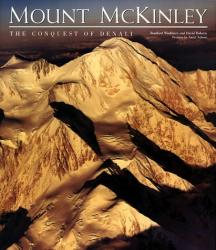
|
Denali (20,320ft / 6194m)West Buttress RouteMay 22 - June 5, 2013 |
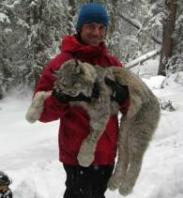
|
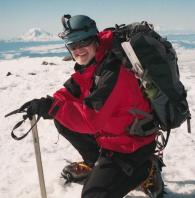
|
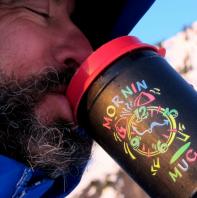
|
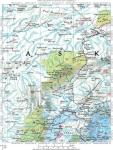
|
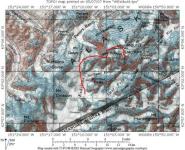
|

|
Adam, Mark and I took advantage of excellent weather and summitted Denali on June 1, 2013. We flew into Anchorage on May 21st and met my mother and father in law, Dwight and Carole, at the airport and we loaded in our 8 bags (three expedition packs, four large duffle bags, and three pairs of skis!) into their new camper. It was wondeful seeing Dwight and Carole and being back in Alaska. After a great night's sleep at their house in Wasilla and a hearty breakfast we organized our gear and drove up to Talkeetna. We ate a quick lunch at the historic Talkeetna Roadhouse before our noon interview with the Park Service. The climbing ranger, Joey, showed us some slides of the mountain and the route and went over safety issues and stressed good decision making on our expedition. We were assigned our lovely, green, Clean Mountain Can (CMC), a box of compostable bags and then set off for Talkeetna Air Taxi where we would fly to base camp.
After weighing our gear (we were allowed 125lbs per person and we tipped the scales at just over 417lbs) we put our gear on a cart and waited for our name to be called for our turn to fly. The weather was fair which allowed many planes to fly climbers and tourists alike. Once it appeared that we were going to fly out, we said goodbye to Dwight and Carole and thanked them for all their generous support.
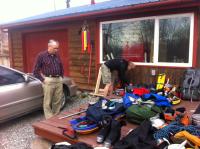
|
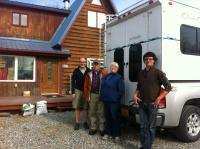
|
It wasn't very long when our name was called and our gear was loaded onto a Dehavilland Beaver. We were joined on our flight by "June" a soloist form Japan. He must have traveled by night because after landing and saying good bye and good luck at base camp, I didn't see him at any of the camps. After being greeted by the base camp manager, Lisa, we were given our three cans of fuel. We used half of one of the cans to fill our two 33 oz fuel bottles then buried the remaing half gallon along with four dinners in a cache. This is done in case poor weather prevented us from flying out and we got stuck at basecamp on our return trip.
After loading up our sleds and packs, we put on our harnesses, roped up and started skiing out of camp. We all felt good to finally be on our way after so many months of preparation. Adam had been working on a Lynx Habitat project in the backcountry of southwest Colorado all winter long so we had to make the most of the few opportunties to talk from November to March. But between all the emails, texts, and phone calls we were able to be well organized and prepared.
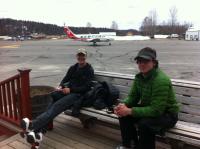
|
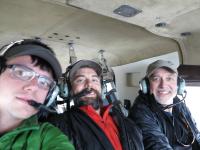
|
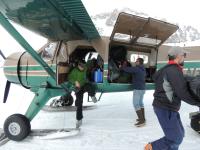
|
I should say we were almost over prepared- with food that is. Being a backcountry ranger, Adam spends most of his summers on the trails in the mountains so his tolerance for pre-packaged, dehydrated food has waned over the years! Accordingly, when he offered to take charge of preparing real food meals, Mark and I overwhelming said, "Sure!". So while the added weight made our packs a little heavier, we were spoiled by dinners such as penne pasta with real provolone cheese, fresh onion, and chicken, cheese tortellini with smoked salmon (thank you, Mark, for hauling in the salmon for my birthday!), fresh bell peppers in burritos with cheddar cheese complete with salsa, "green spice" and Tapitio hot sauce, and minestrone soup with more vegetables than I could count! Did I mention the several pounds of precooked bacon Adam brought also?
Mark's wife, Penny, also prepared us amazing breakfasts complete with scones, biscuits, maple pecan syrup, peanut butter, pancakes, quinoa with brown sugar and dates, granola with dried fruit and nuts, and oatmeal with ginger "Power balls". I told Mark and Adam that I would be eating better on this trip than I had over the past few months!
If there was one thing that might throw our expedition a curve ball, however, then it was Mark and Adam's ski boots. Adam had recently replaced his well used Black Diamond Factor liners with a pair of Intuition Power Wraps, and Mark picked up a pair of Black Diamond Prime AT boots from Craigslist. Unfortunately, neither of them had much time to break them in before our trip. We were all a little concerned with the hot spots that turned to blisters that became sores. Even though I had hundreds of hours logged in my Scarpa Spirit 3's, I developed a small sore on my right lateral malleolus where I have a titanium plate. But we all were able to cope by adjusting our strides and making use of the extensive first aid kits: percoset, vicadin, and duct tape. Just kidding!

|
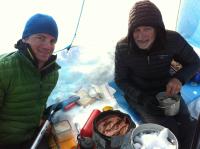
|
This was Adam's first time to Alaska and Mark's first time to the Alaska Range so our collective awe and marvel that each of us verbally exclaimed at every new vista was understandable!
It was great to finally be on the mountain after so many months of emails, phone calls, discussions with friends and colleagues to pick their brains, training climbs and reading. I lead out down the boot pack with Mark in the middle and Adam at the end. I think we were all a little concerned about how it would be to ski with sleds as we headed out. Although we had practiced skiing with sleds at Stevens Pass, Snoqualmie Pass, and Mt Baker it's difficult to simulate the excact terrain that we would be on. Afterall, there's only one Kahiltna Glacier in the world and it's rather difficult to get to. At over 40 miles long, it is the longest glacier in the Alaska Range. It runs roughly due douth from Kahiltna Pass at 10,300' past Mt Foraker and Mt Hunter and continues to the south where it feeds the Kahiltna River at 1000'.
The gentle grade of the descent out of base camp allowed us to control our sleds pretty well. This 300' descent out of basecamp is known as "heartbreak hill" because on the return trip out, it poses one last uphill challenge before reaching basecamp. We would learn later than Denali always has another obstacle around the corner and never lets up until the very top. It's difficult to say which day was the hardest since each day on the mountain involved a different challenge and individually we each had good days and rough days! But as my friend Greg Moo says, it's a gift to have the opportunity and the ability to experience such an amazing place!
Many climbers choose to stay the first night in basecamp to organize but we wanted to "make hay while the sun was shining" so we packed up and pushed up to Camp 1, the 7800' camp.
Even though it's only 500' higher than base camp, it's almost 6 miles up the glacier and with the heaviest packs and sleds that we would be carrying on the entire expedition it makes for a tiring day (or evening in our case!). We arrived at Camp 1 around 1:30am and were happy to take off our heavy packs. We made a single carry which means we carried all of our gear in a single push. For the rest of the trip we would be making mostly double carries where we bring only half of our gear to the next camp, bury it in the snow or "cache it", then return back to the lower camp where we rest before moving to that next higher camp the following day with the other half of our gear. This "climb high, sleep low" practice is the best way to not only move supplies up the mountain but also to acclimate. By spending a few hours at elevation, it gives the body a "taste" of what it's going to experience the next day.
We quickly set up the tent and MegaMid, a floorless tent that we used as our kitchen, unpacked our pads and sleeping bags and went to sleep! We slept in until 11am or so and had a leisurely breakfast then we loaded up our packs and sleds with gear and supplies to cache at the 9700' camp. It took a while to get packed so we rolled out of camp around 3pm. There was a two person team camped next to us, Luca and Ufrat, from Venice by way of San Francisco. The climbers you meet at the first camp are typically on the same schedule so you see them coming and going as you make your way up the mountain. We also met the Swedish two man team of Christian and Christian. They were carrying up the the 11,300' camp as we cached at the 10,000' Kahiltna Pass camp.
The 9700' camp looked pretty small and I didn't recognize it so we continued up the glacier another hour to where we were told another camp was. We only found some wands that marked other team's caches so we kept going. As it turned out we ended up climbing up to the 10,000' Kahiltna Pass camp where there were a few other caches but no tents. We found a few tent platforms so we picked the flattest one and set up our second tent. Since no one was camped here and we knew that most climbers would bypass this camp and continue up to the 11,300' camp we felt it was ok to set up the tent and leave it. Generally at the busier camps, it's recommended to not take up a tent site if you aren't going to camp there. This allows parties arriving late from to be able to easily set up their tents without having to build a camp site complete with snow walls from scratch. This process can typically take several hours and in a storm it can be very difficult. But we were the only ones here and there were several other platforms and walls to choose from. When we realized where we were, we remembered our interview at the Talkeetna Ranger Station where Joey had told us to not camp at the Kahiltna Pass camp because the winds coming whipping in over the pass and will pummel you. Well, lucky for us the weather was perfect and there was only a light breeze! This was the second time I lucked out by favorable weather allowing me to camp at an otherise inhospitable place. In 2007, Scott, Kim and I camped at the 16,000' camp at the top of the headwall during a single carry up to 17,200' camp. Again the weather had been perfect and we were the only ones camped there.
Once we set up the tent, we cached our gear from our packs inside the tent. Because we had brought so much gear up on our first carry we decided to leave two of our sleds and only take one back down for the next day. We were about three hours too late for the ski back down to the 7600'camp. By this time in the evening all the soft, corn snow had turned to ice so instead of being able to quickly schuss down Ski Hill, it was more like survival skiing in a power wedge. We made it back down to camp, slowly but surely and vowed to get an earlier start on our next carry so we would avoid the same mistake.
The next day we moved up to the 10,000' camp and saw our friends, Christian and Christian who were moving up to the Motorcycle Hill (11,200') camp. Mark and Adam built a great kitchen while I cut blocks to protect the tent.I assumed the winds would be coming down from the pass, so I built our snow wall above our tent. The winds, however, came up the glacier and through the pass. Oops. Well, fortunately for us the weather was stellar and we didn't have any trouble.
Since we were only 1300' below our next camp we decided to make a single carry up to the next camp. It worked well and we were able to gain a day on our planned schedule! The Motorcycle Hill camp was the busiest camp by far. There were probably 40 tents in camp. Parties were heading down and heading up. Once we arrived we dropped our packs, disconnected from our sleds and walked around to find a suitable camp site. I found one that I thought would work but then Mark and Adam found a better one. So we set up the EV3 and the Mega Mid then Adam and I went for a ski!
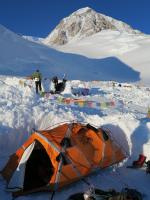
|

|
We had seen a steep face just west of the camp that looked like it would be a proud ski descent so we got our light packs and headed up Motorcycle hill. It was wonderful not having the burden of a 75lb pack and a 45lb sled. We felt great and quickly skinned up to the top of the hill. From this vantage point we could look back down and see Mt Foraker in all it's glory. Wow, what an incredible mountain! We added yet another peak to our list of mountains to climb and continued to take in the amazing views. From below Squirrel Hill we could look down into Peters Basin and up to the West Buttress proper. There is a spicy looking couloir coming down climbers left of the west buttress that looked like it would "go"! We thought of our friend, Todd Kilcup, and I mentioned that he would be all over that! He loves steep, technical descents. I, on the other hand, choose LIFE!
Adam and I could see that the dark patches on our intended descent were actually ice, so we decided to ski down the other direction and moved out, skiers left, of the route we skinned up. The afternoon sun and softened things up and we were able to make some nice turns back down to camp. Mark took a few videos of us skiing back down.
The following day we loaded up our sleds and made a carry up to Windy Corner at 13,200'. It was pretty steep going up Motorcycle Hill so we took a long break at the top of it. Here we met a four member team from Sweden and a party of two from Canada, Dominic and Paul. As it turned out, when we reached Windy Corner, Paul had brought his skis up with him as did Adam so we made a trade: Dominic tied in with Mark and I to hike back down and Paul and Adam skied back down to camp. Adam had spied a cool line that was above the line that he and I skied the day before. From what they said afterwards, it sounded like a great ski down. Mark and I had fun getting to know Dom. So it was a great day all the way around.
But the next morning Mark and Adam said they felt a little tired from the haul up to 13,200' so we took our first rest day. We had slept in and had a leisurely day. In the afternoon, Adam and I made another ski tour to the right of where we had skied before. Adam got a great shot of me skinning below some huge seracs and across a big crevasse. I don't know which I was most concerned about: the towering ice blocks above me or the obvious depression made from the snow covering the crevasse. So, I didn't waste any time hanging out and pondering the question! I made a bee line to the wide open slope where we took off our skins, cinched down our packs and schussed down the untracked slope! Mark got a nice video of Adam and I skiing the slope or as I like to say: making our art! It's fun to look back on our tracks and critique them. Adam and I agree that there are many unwritten rules, if you will, about "making art with skis". First of all, you don't ski over someone else's "art". You ski next to theirs. Close but not too close. It's important to leave enough "white space" between the "art".
Right before Mark starting shooting his video, one of the climbers who were watching us said, "This had better be good!" I was glad I didn't hear that because as "artists" we ski-carve for ourselves, not for the entertainment of the masses! ;) Well, maybe a little bit for the masses! I had been worrying about the debate to bring snowshoes vs skis. Skis are more efficient means of travel and provide for great entertainment on "rest days" but they require specialized boots (meaning we had to bring randonee boots in addition to our mountaineering boots) and because skiing downhill with sleds can be problematic.
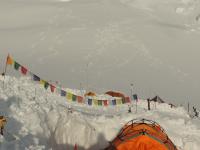
|
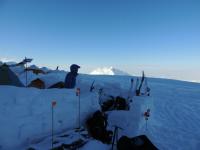
|
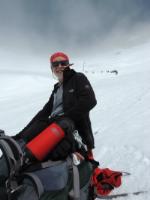
|
In 2007 when Scott, Kim, and I were descending from the 11,200' camp we saw a rope team of four 20-something, strong, young skiers spent AN HOUR making their way out of camp. They each had heavy packs and sleds and when one fell to the left, another would fall to the right. They spent more time righting their sleds than they did skiing. They were from the Colorado Mountain School and they had made the summit during the good weather and were now heading down. One of their older chaperones was standing there watching this ordeal, so I walked over to him and nonchalantly asked, "You guys are from Colorado, right?" The man kept looking ahead, nodded and said, "yep". I continued, "There's skiing in Colorado, isn't there?" The man just smiled, looked down at the ground shaking his head as we walked away! We both got a good chuckle.
So this memory was stuck in my mind as Mark, Adam and I discussed the pros and cons of skis. In the end we took skis and I wouldn't go back again with them. They were definitely the right choice for our team. They not only offer a more efficient means of travel but a safer one also because the skis disperse the weight of the skier so you are less likely to punch through the roof of a partially covered crevasse. And skiing down was not a problem at all because of some tips I got from picking the brains of my co-worker, Dave Kratcsh, and my friend, Jeff Witt, who between them have close to 15 summits of Denali by several various routes. The use of a "sled brake" was very helpful to increase the friction of the sled so that it wouldn't pick up speed and slide past you while skiing downhill. The "sled brake" is nothing more than a ten foot piece of old climbing rope with overhand knots tied every foot or so. This knotted rope is then tied to the sides of the front third of the sled so that it can be flipped up and ride on top of the sled while on the flats or uphill sections and then flipped down and ride underneath the sled on steeper sections. Brilliant!
After Adam and I skied back to camp we looked back up motorcycle hill and admired our tracks and commented on how great the snow conditions were! Mark, Adam, and I had skied in some spectacular places but this was in a category of it's own!
The next morning we woke up with the sun, had a great breakfast and then loaded up the sleds with gear that we wouldn't need for three days. Preparing for this day's carry required a little more forethought because we weren't planning to carry it to our next camp. The common strategy is to cache your gear at 13,200' just above "Windy Corner", not all the way up to the 14,200' camp. Then the following day you move to the 14,200' "Basin Camp" aka "Medical Camp" aka "Advanced Base Camp". Then the following day you climb back down to 13,200', retrieve the cache and return to the 14,200' camp. This tactic makes for a less strenuous first day, provides adequate acclimitization, and provides for enough energy for the big push up to the 14,200' camp the following day.

|

|
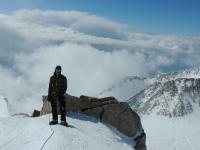
|
Following our rest day we were able to move up to the 14,200' camp without too much difficulty and we even had enough energy in reserve to pass a few parties from Windy Corner up to the 14,200' camp! Mark had chosen to cache his skis back down at the 11,200' camp while Adam and I carried our skis up on our packs. We had our mountaineering boots also which made for big heavy packs but we were looking forward to more great skiing on rest days! Just before we reached camp we heard a crash and looked up to our left to see a large serac, or ice cliff, collapse and start tumbling down the mountain! It broke into car sized blocks and bounced over the terrain as it rocketed down past some skiers who were quickly moving out of it's path. We were still far enough away, but I said, "Yeah...let's keep moving just in case!" The blocks stopped well short of us, but this was a great example of why many climbers chose to bring helmets for this section of the climb. There were several steep rocky faces that let loose periodically from Windy Corner up to ABC, as evidenced by all the scattered rocks and boulders among the boot pack.
We dropped our packs and coiled the rope once we reached the camp and made off in various directions in search of our next home away from home. We found one that had leaning walls but otherwise was in a good location and was large enough to accomodate both our cook tent and our sleeping tent. We settled on a vacated site that had sagging snow walls but it had enough room for our cook tent and our sleeping tent, so we brought our packs over and began the work of building our fourth camp.
While we worked a group of skiers who were camped near us stopped near our snow wall and lit up their cigarettes. They were members of a sponsored team from a German ski company.
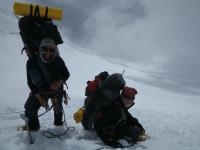
|

|
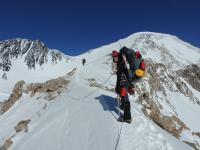
|
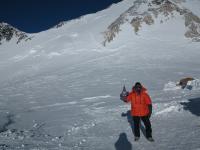
|

|

|

|
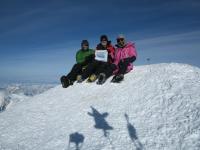
|
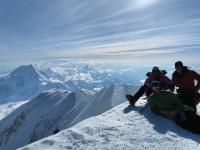
|
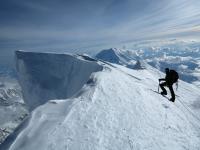
|
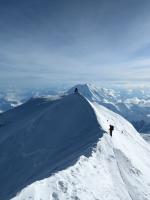
|
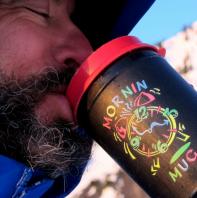
|

|
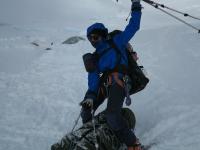
|

|

|
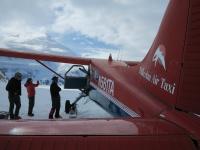
|
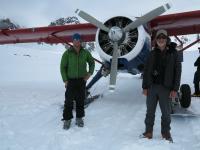
|

|
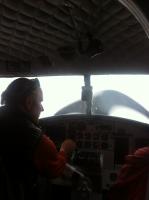
|
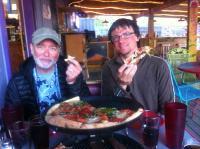
|
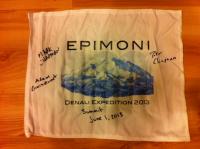
|